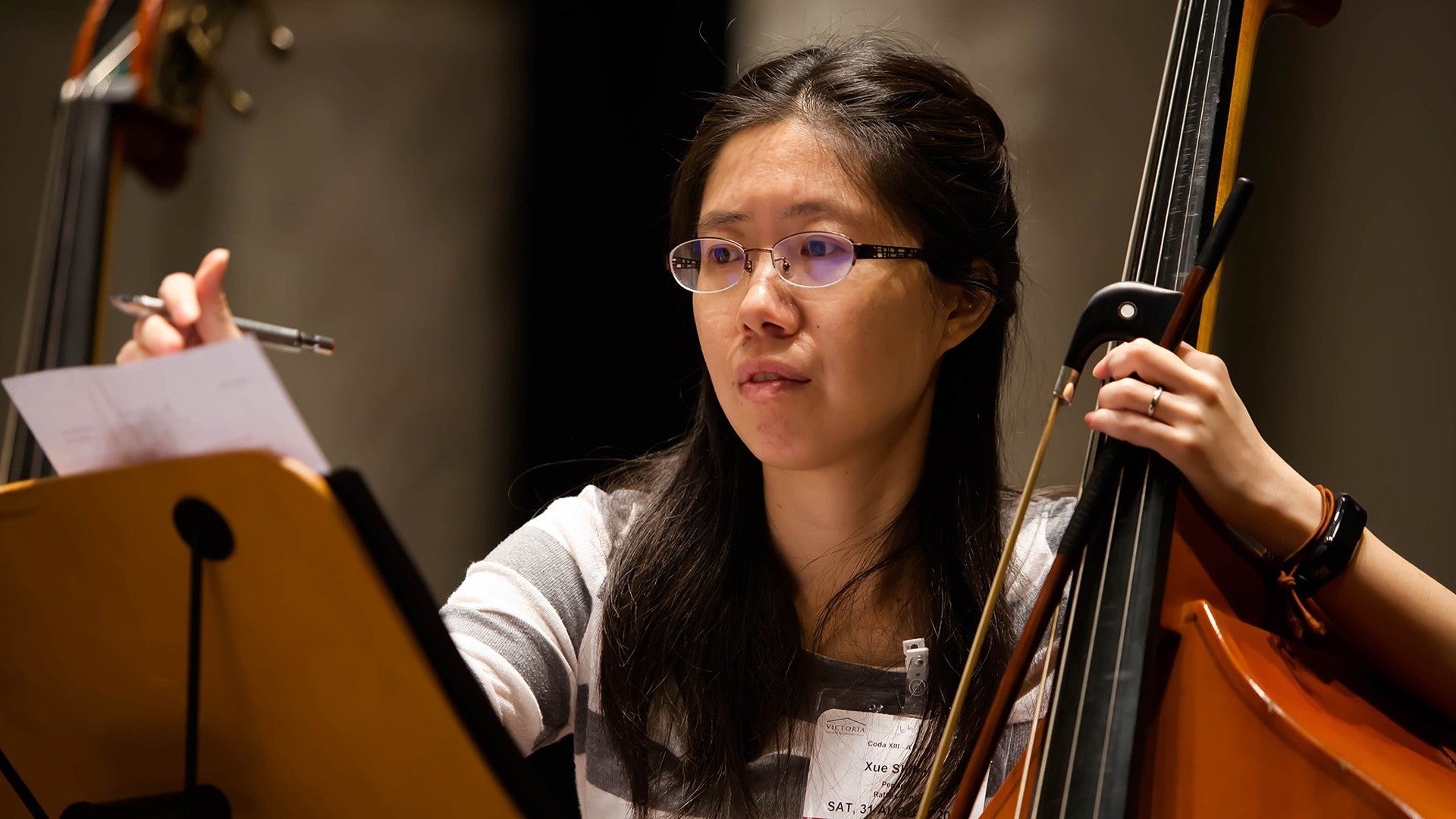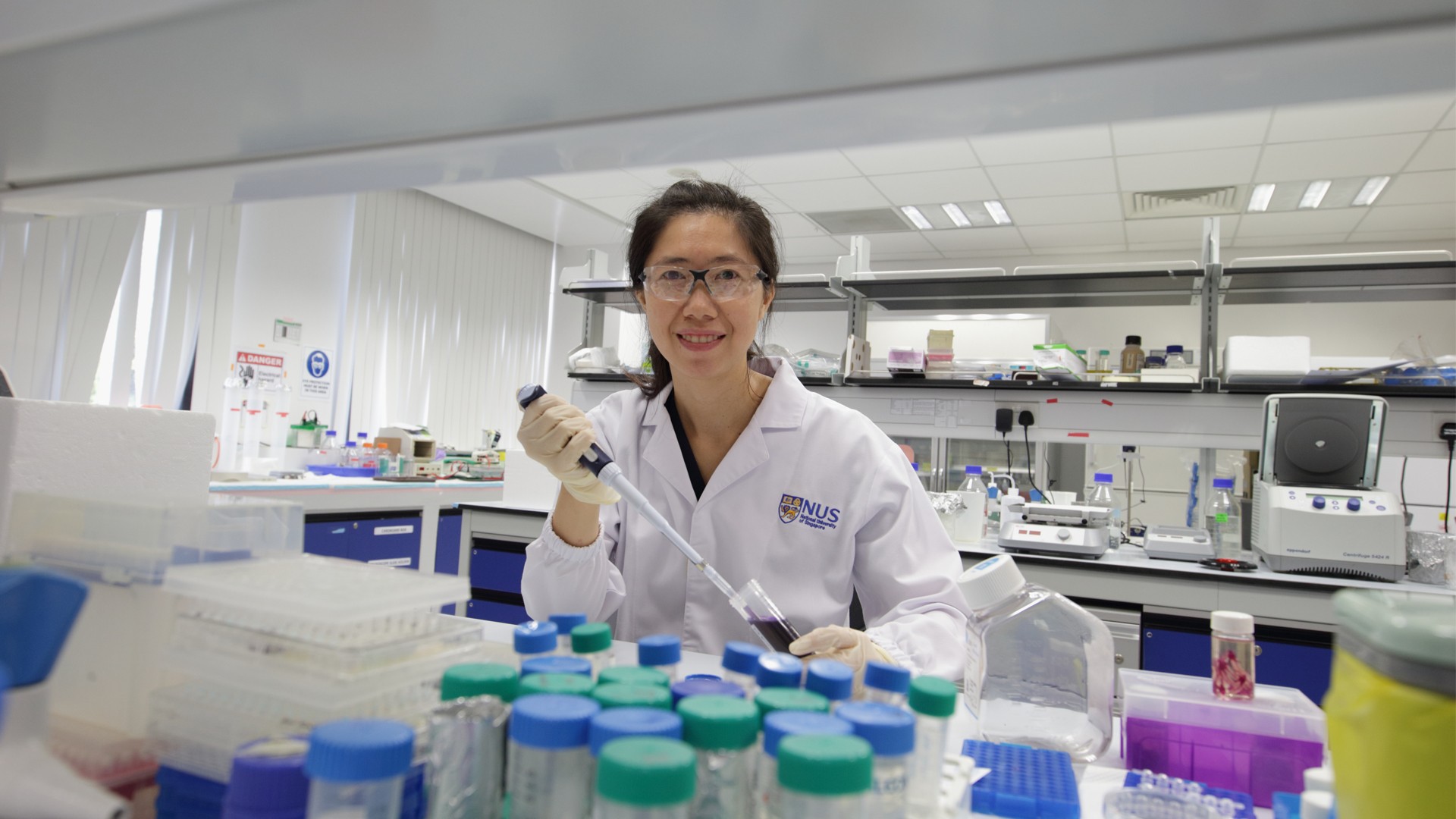Appreciating the “music” of gene interactions in a growing embryo
September 08, 2022
Presidential Young Professor Xue Shifeng is a cutting-edge developmental biologist – and an accomplished musician. (Photo credit: Quek Tee Chye)
“Everything has to be in place and everything has to go right – there’s a predefined score. But occasionally one plays wrong notes. If the mistakes are big enough, the whole piece breaks down.”
For Presidential Young Professor Xue Shifeng, this concept applies whether she is playing her double bass in the band, or in her lab at NUS Biological Sciences investigating how genetic mutations affect the development of an embryo, like a symphony being performed by Nature itself.
A life of music and science
The 2018 Young Scientist Award winner initially wanted to be a sound engineer. Her mother was a consumer electronics product engineer and would often bring work home to do – not stacks of paperwork, but partially assembled electronic devices that she was troubleshooting, like radios. The young Xue knew what a radio looked like on the inside and how it worked, and even listened to music on some of those test sets. She also learnt to play the electronic organ and double bass.
But when she went to junior college, she got hooked on something else – the genes of living organisms. She was amazed how genetic sequences made up of only four base pairs could encode the entire complexity of life on earth. “I was really interested in how you could manipulate genes, copy genes and cut genes using tools in the lab,” said Asst Prof Xue.
She went on to study at the University of California at San Diego, where her fervour for the topic was further stoked at an undergraduate embryology lab class watching frog and fish grow from eggs.
At that point, she wanted to walk into a lab right away and do a research project on embryonic development. Alas, she could not find a suitable lab that had a vacancy for an undergraduate. It didn’t deter her, however. She laid plans. She searched for a lab where she could do a PhD on the topic she wanted, and it eventually brought her to the University of California in San Francisco.
Of course, success did not come easy. Ms Xue was studying ribosomes, the tiny round molecular complexes in the cell that translate RNA sequences into the proteins essential for cellular activities. She wanted to prove that a tiny part of the messenger RNA sequence, only about 300 base pairs long, served as a tag that helped the correct type of ribosome identify the sequence from which to make protein.
“We made a laboratory model that was completely normal except that it did not have this little non-coding part of a gene. It was a very long experiment.”
She lived in suspense for more than a year, ironing out the technical kinks in the experiment.
Finally, the time came to check. If her theory was correct, the model would still have the RNA floating around in the cells, but it would not be translated into protein anymore because the tag was missing.
Using molecular methods, she searched for the protein in the cells, and found nothing. That was the eureka moment. Overcome with euphoria, she called her advisor’s mobile but the latter was driving and did not pick up. The advisor eventually arrived in the lab and said, “I knew you had something, because you never call me!”
Applied research with a blue-skies spirit
Asst Prof Xue is now a principal investigator charting her own research frontiers and mentoring her own PhD students. One of their latest projects is to better understand how mutations in a gene called SMCHD1 cause a range of serious genetic diseases including being born without a nose, a rare condition called Bosma arhinia microphthalmia syndrome. They have to figure out the right and wrong notes of the “music” without having a printed score, and which “instruments” are playing them, by modifying the genes, growing the cells and observing what happens.

Asst Prof Xue at her personal “cubicle” in her lab at NUS Biological Sciences.
It is a long time before anyone can implant stem cells onto the patient’s face to grow a nose, but Asst Prof Xue’s research has already proven useful for treating a type of muscular dystrophy, which is caused by the same gene. Furthermore, the different cell types from the nose that grow on her lab’s Petri dishes are helping the researchers better understand how the face is formed during development. As craniofacial disorders are among the most common birth defects, this could eventually lead to prevention or treatments for such defects.
Asst Prof Xue’s research not only contributes to the NUS key research area of Biomedical Science and Translational Medicine, but also exemplifies the synergy of applied and basic or blue-skies research that Prof Xue feels is the way forward.
Imparting knowledge to others
Asst Prof Xue’s mission is not only to do research but also to spread knowledge far and wide. During her PhD, she took time off to teach genetics to young children at the local tech museum and made the rounds at high schools in the area as well. More recently, an undergraduate who did a project at her lab was so inspired by the experience that the student Photoshopped the faces of her and the lab team onto Power Rangers characters.
But Asst Prof Xue’s young daughter is getting it easy for the time being. At night, mum puts daughter into bed before continuing with work. The child is too young to visit the lab or understand RNA transcription – but nevertheless on her way to discovering the symphony of life.
Original article from NUS News.


